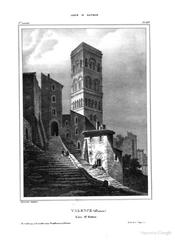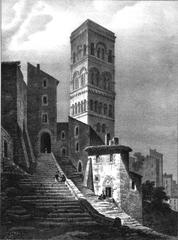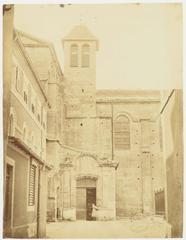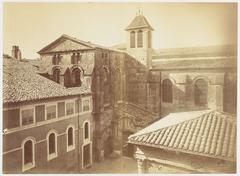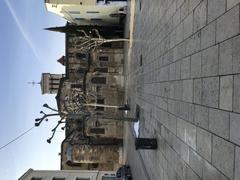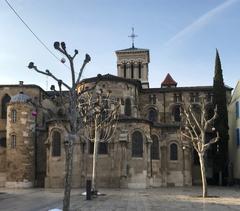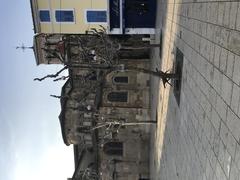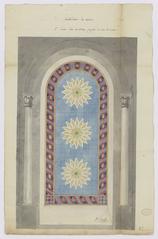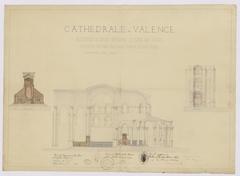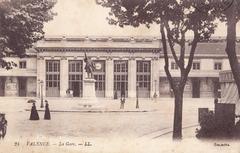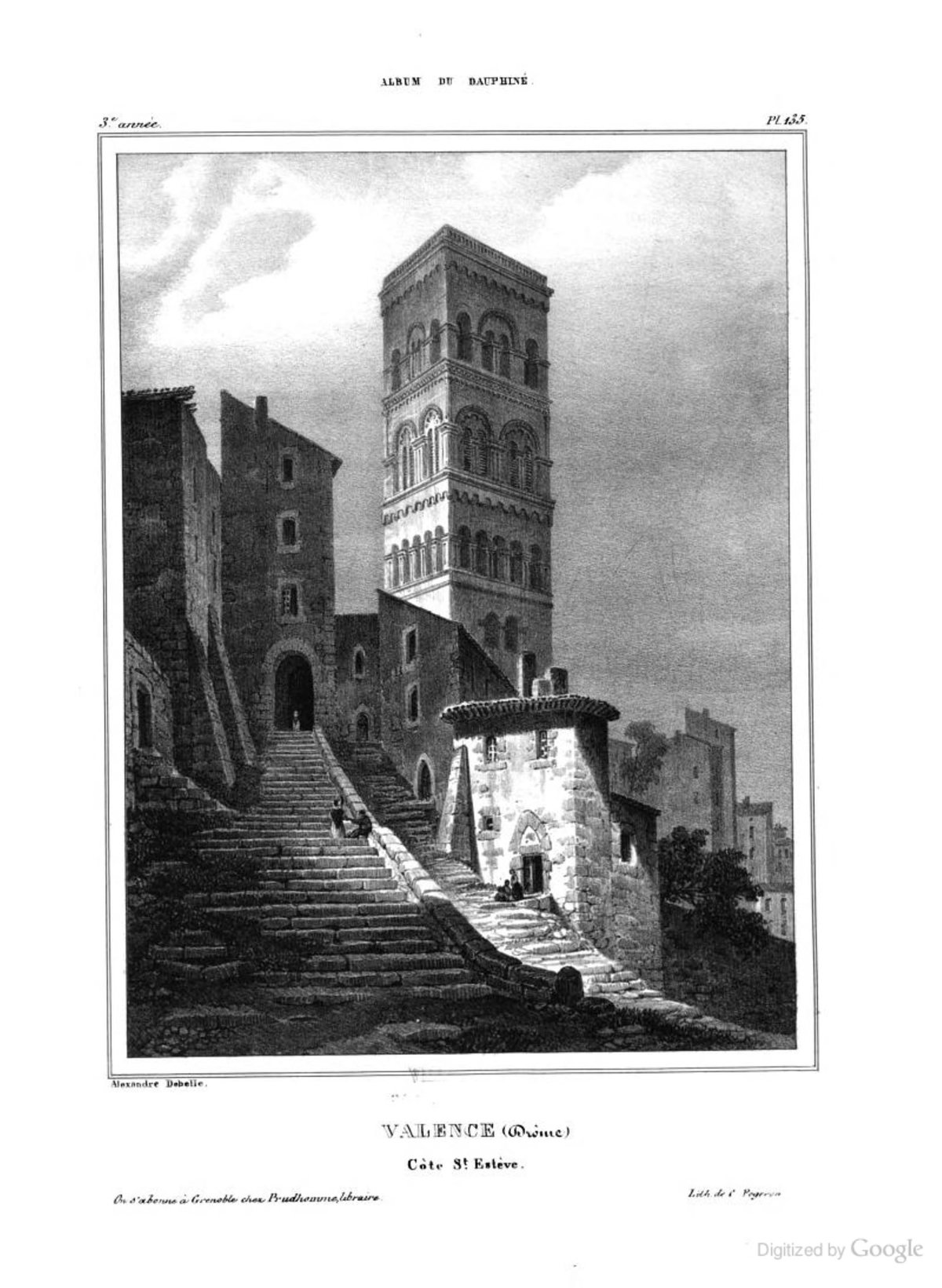
Valence Cathedral: Visiting Hours, Tickets, and Historical Sites in Valence
Date: 14/06/2025
Introduction
Valence Cathedral, officially known as the Cathédrale Saint-Apollinaire de Valence, stands as a testament to centuries of religious, cultural, and architectural history in the heart of Valence, Drôme, France. As the city’s oldest monument, this remarkable cathedral traces its origins to the 11th century and showcases an impressive blend of Romanesque, Gothic, and Renaissance styles. Consecrated by Pope Urban II in 1095, it has survived wars, natural disasters, and periods of decline—emerging as both a spiritual center and a symbol of resilience for the region.
Today, Valence Cathedral invites visitors to explore its serene nave, intricate capitals, vibrant stained glass, and unique features such as the monument to Pope Pius VI. Located near other major attractions like the Museum of Art and Archaeology and the bustling Place des Clercs, the cathedral serves as a focal point for cultural discovery in southeastern France. This guide offers a comprehensive overview of Valence Cathedral’s history, architecture, visitor information, and travel tips, making it an essential resource for anyone planning a visit. For the most current details on hours and events, consult the official Valence Cathedral website and the Valence Romans Tourisme portal.
Historical Overview
Foundations and Consecration
Valence Cathedral’s origins date to the late 11th century, with construction initiated under Bishop Gontard. The cathedral was consecrated on August 5, 1095, by Pope Urban II, who dedicated it to Saint Apollinaris, Valence’s first bishop (Valence Romans Tourisme). Built on Gallo-Roman foundations, the site incorporates ancient stones, some with Latin inscriptions—a powerful symbol of continuity and reverence for sacred spaces across eras.
Medieval Modifications and Resilience
The cathedral’s Romanesque core features a nave, side aisles, transept, and an apse with an ambulatory, facilitating the flow of pilgrims along the Santiago de Compostela route. Over the Middle Ages, the cathedral underwent several modifications, including the replacement of its spire after a lightning strike in 1281 and the addition of chapels in the 15th century. The building suffered significant damage during the 16th-century Wars of Religion when Huguenot forces set fire to it in 1562 and 1567. Restoration efforts in the 17th century sought to return the cathedral to its Romanesque roots, reinforcing its symbolic role in the Catholic community.
Later Transformations and Modern Preservation
The 18th and 19th centuries saw further transformations, particularly following the death of Pope Pius VI in Valence in 1799—his heart and entrails remain preserved in the cathedral, and a neoclassical monument commemorates him. Lightning and structural issues led to the reconstruction of the bell tower and porch in the 19th century under architect Antoine-Nicolas-Louis Bailly. The cathedral was classified as a historic monument in 1862. Recent decades have focused on preservation and recovery from minor incidents, such as a limited fire in 2021.
Architectural and Artistic Highlights
Romanesque Foundations and Distinctive Features
Valence Cathedral is a quintessential example of southern French Romanesque architecture. Its use of local molasse stone gives the structure a warm, earthy tone, while polychrome stonework and decorative arcading lend visual interest to the façade and apse. The square bell tower, with its white stone contrasting against the body of the cathedral, is a prominent feature, supported by buttresses and topped with a gently sloping roof (France Voyage).
The Cloister and the Pendentif
Adjacent to the cathedral is the old cloister, a tranquil space that once formed the heart of monastic life. Here, visitors find the Pendentif, a unique Renaissance funerary monument (1548) built of molasse stone, notable for its domed vault and elegant pendentives (Discover Walks).
Interior Spaces
Inside, the cathedral’s nave is marked by rhythmic rounded arches, sturdy columns, and richly carved capitals—hallmarks of Romanesque design. The semi-circular apse, surrounded by chapels, is adorned with polychrome stonework and illuminated by stained glass, creating a contemplative atmosphere. Later additions include sculpted capitals, painted decorations, and an 18th-century grand organ.
Monument to Pope Pius VI
In the choir area stands a monument to Pope Pius VI, who died in Valence in 1799. Its neoclassical style provides a striking contrast to the Romanesque architecture, underscoring the cathedral’s multifaceted history.
Stained Glass and Decorative Art
Although many original stained-glass windows were lost, the current installations fill the interior with colorful light, enhancing the spiritual ambiance (Atrium Hotel). The cathedral also features master paintings and tapestries from the 15th and 16th centuries.
Visiting Valence Cathedral: Practical Information
Location and Getting There
Valence Cathedral is centrally located in the Place des Ormeaux, within easy walking distance from Valence’s main squares and attractions. The Valence Ville railway station is about 1 km away, and the area is well-served by local buses, taxis, and pedestrian routes (drome-cestmanature.com).
Opening Hours (as of June 2025)
- Wednesday, Thursday, Friday: 15:00–18:00
- Saturday: 10:00–12:00 and 14:00–16:30
- Sunday: 09:00–11:00
- Closed: Monday and Tuesday
Hours may vary for holidays, special events, or restoration. Always check the official tourism website before visiting.
Admission and Tickets
- Entry: Free for all visitors
- Guided Tours: Available for a fee; recommended for a deeper understanding of the cathedral’s art and history. Book tours via Valence Romans Tourisme or the cathedral’s official site.
Accessibility and Visitor Facilities
- Mobility: The cathedral is accessible by gently sloping streets. Some historic areas may be challenging for those with limited mobility; inquire in advance for details.
- Restrooms: Not available inside the cathedral, but nearby facilities can be found in public spaces and cafés.
- Seating: Benches and pews are available for visitors.
Photography and Etiquette
- Photography: Permitted in most areas, but flash may be restricted.
- Dress Code: Modest attire is encouraged, especially during services.
- Silence: Please maintain a respectful quiet, particularly during religious ceremonies.
Religious Services and Community Life
Valence Cathedral remains an active place of worship, hosting regular Masses, sacraments, and major religious festivals. The monument to Pope Pius VI and the cathedral’s deep history make it a site of pilgrimage and remembrance. For current service times, check the official cathedral website or inquire locally.
Nearby Attractions
- Place des Clercs: A lively historic square, popular for its market and pastel-colored houses.
- Musée de Valence: Located in the former episcopal palace next door, featuring art and archaeological collections (overyourplace.com).
- Maison des Têtes: Notable for its ornate Renaissance façade.
- Local Dining: Sample regional specialties such as ravioli de Valence and the “Suisse” pastry at nearby cafés (thecrazytourist.com).
Best Times to Visit
- Seasons: Spring and early autumn offer mild weather and fewer crowds.
- Weekdays: Morning visits are typically quieter.
- Market Days: Saturdays bring vibrant activity to nearby Place des Clercs; plan accordingly.
Frequently Asked Questions (FAQ)
Q: Is there an entry fee to visit Valence Cathedral?
A: No, entry is free for all visitors.
Q: How can I book a guided tour?
A: Contact Valence Romans Tourisme or check the cathedral’s official website for current tour options.
Q: Is the cathedral wheelchair accessible?
A: Some areas may be challenging. Visitors with mobility concerns should inquire in advance.
Q: Are there special events or photography highlights?
A: The monument to Pope Pius VI, Chapelle du Saint Sacrement, and the Romanesque façade are notable highlights.
Q: When is the best time to visit?
A: Weekday mornings during spring or early autumn are ideal for a peaceful experience.
Visuals and Interactive Media

- Explore a virtual tour of Valence Cathedral
- Use descriptive alt text such as “Valence Cathedral white stone bell tower” or “Interior nave with Romanesque arches” for accessibility and SEO.
Plan Your Visit and Stay Updated
Valence Cathedral continues to inspire visitors with its layered history, architectural beauty, and vibrant community life. The site’s accessibility, free admission, and proximity to other cultural landmarks make it a must-see in the Rhône-Alpes region. To enhance your visit, use digital tools like the Audiala app for real-time updates on opening hours, guided tours, and special events. Stay connected with local tourism offices and official websites for the latest information.
Sources
- Valence Cathedral Official Website
- Valence Romans Tourisme - Cathedral Details
- Drome C’est Ma Nature - Cathedral Guide
- Discover Walks - Top Things to Do in Valence
- France Voyage - Valence Tourism
- Atrium Hotel - Architectural Walks in Valence
- The Crazy Tourist - Best Things to Do in Valence
- Over Your Place - Valence Travel Guide
- Visit Places France - Cathedral Saint Apollinaire
